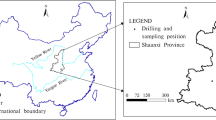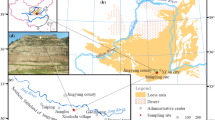Abstract
The pore structure of loess is crucial for understanding the transport of water in soil and affects soil permeability. In this study, X-ray computed tomography (X-ray CT) technology was used to establish the macropore structure of remolded loess, and analyze the influence of macropore on permeability. A new specific and efficient workflow for constructing macropore structure of loess samples was established. The workflow improves the precision of image segmentation and provides a new method for creating 3D soil macropore structure. The macropore structure showed that the macro-porosity variation of loess sample was clearly anisotropic. Based on the macropore structure model, a modified Kozeny–Carman equation was suggested to investigate the hydraulic conductivity anisotropy of the loess sample. Subsequently, permeability test was used to verify the results calculated by equation. Both the results showed that hydraulic conductivity was positively correlated with the uniformity of the porosity changes in each direction. It provides a new method to estimate the anisotropy of hydraulic conductivity based on macropore structure model.














Similar content being viewed by others
References
Aydogan DB, Hyttinen J (2014) Characterization of microstructures using contour tree connectivity for fluid flow analysis. J R Soc Interface 11:20131042
Chapuis RP, Aubertin M (2003) On the use of the Kozeny–Carman equation to predict the hydraulic conductivity of soils. Can Geotech J 40:616–628
Cortina-Januchs G, Quintanilla J, Vega-Corona A, Tarquis AM, Andina D (2011) Detection of pore space in CT soil images using artificial neural networks. Biogeosciences 8:279–288
Dong H, Huang R, Gao Q-F (2017) Rainfall infiltration performance and its relation to mesoscopic structural properties of a gravelly soil slope. Eng Geol 230:1–10
Elliot TR, Reynolds WD, Heck RJ (2010) Use of existing pore models and X-ray computed tomography to predict saturated soil hydraulic conductivity. Geoderma 156:133–142
Ferreira TR, Pires LF, Wildenschild D, Heck RJ, Antonino ACD (2018) X-ray microtomography analysis of lime application effects on soil porous system. Geoderma 324:119–130
Frost J, Park J (2003) A critical assessment of the moist tamping technique. Geotech Test J 26:57–70
Gao Y, Qian H, Li X, Chen J, Jia H (2018) Effects of lime treatment on the hydraulic conductivity and microstructure of loess. Environ Earth Sci 77:529
Grayling KM, Young SD, Roberts CJ, de Heer MI, Shirley IM, Sturrock CJ, Mooney SJ (2018) The application of X-ray micro computed tomography imaging for tracing particle movement in soil. Geoderma 321:8–14
Hapca S, Houston A, Otten W, Baveye P (2013) New local thresholding method for soil images by minimizing grayscale intra-class variance. Vadose Zone J. https://doi.org/10.2136/vzj2012.0172
Hong B, Li X-A, Wang L, Li L-C (2019) Temporal variation in the permeability anisotropy behavior of the Malan loess in northern Shaanxi Province, China: an experimental study. Environ Earth Sci 78:447
Ishibashi I, Hazarika H (2015) Soil mechanics fundamentals and applications. Apple Academic Press Inc., Burlington
Jiang M, ZhangHu FGH, Cui Y, Peng J (2014) Structural characterization of natural loess and remolded loess under triaxial tests. Eng Geol 181:249–260
Kapur JN, Sahoo PK, Wong AKC (1985) A new method for gray-level picture thresholding using the entropy of the histogram. Comput Vis Gr Image Process 29:273–285
Ketcham RA, Carlson WD (2001) Acquisition, optimization and interpretation of X-ray computed tomographic imagery: applications to the geosciences. Comput Geosci 27:381–400
Kühne A, Schack-Kirchner H, Hildebrand EE (2012) Gas diffusivity in soils compared to ideal isotropic porous media. J Plant Nutr Soil Sci 175:34–45
Kuncoro PH, Koga K, Kanayama M, Muto Y (2015) Anisotropy of transport properties of a remolded. Compact Andisol 79:1267–1274
Lamandé M, Wildenschild D, Berisso F, Garbout A, Marsh M, Moldrup P, Keller T, Hansen S, de Jonge L, Schjønning P (2013) X-ray CT and laboratory measurements on glacial till subsoil cores. Soil Sci 178:359–368
Li Y (2018) A review of shear and tensile strengths of the Malan Loess in China. Eng Geol 236:4–10
Li P, Qian H (2017) Water in loess. In: Meyers RA (ed) Encyclopedia of sustainability science and technology. Springer, New York, pp 1–17
Li M, Zhang J, Miao XX (2014a) Experimental investigation on compaction properties of solid backfill materials. Min Technol 123:193–198
Li P, Qian H, Wu J (2014b) Accelerate research on land creation. Nature 510:29–31
Li Y, He S, Deng X, Xu Y (2018) Characterization of macropore structure of Malan loess in NW China based on 3D pipe models constructed by using computed tomography technology. J Asian Earth Sci 154:271–279
Li X-A, Li L, Song Y, Hong B, Wang L, Sun J (2019a) Characterization of the mechanisms underlying loess collapsibility for land-creation project in Shaanxi Province, China—a study from a micro perspective. Eng Geol 249:77–88
Li X, Lu Y, Zhang X, Fan W, Lu Y, Pan W (2019b) Quantification of macropores of Malan loess and the hydraulic significance on slope stability by X-ray computed tomography. Environ Earth Sci 78:522
Li Y, Jiang Z, Jiang S, Liu H, Wang B (2019c) Heat flow and thermal evolution of a passive continental margin from shelf to slope—a case study on the Pearl River Mouth Basin, northern South China Sea. J Asian Earth Sci 171:88–102
Luo L, Lin H, Li S (2010) Quantification of 3-D soil macropore networks in different soil types and land uses using computed tomography. J Hydrol 393:53–64
Ma R, Cai C, Li Z, Junguang W, Xiao T, Peng G, Yang W (2015) Evaluation of soil aggregate microstructure and stability under wetting and drying cycles in two Ultisols using synchrotron-based X-ray micro-computed tomography. Soil Tillage Res 149:1–11
Martínez FS, Caniego FJ, García-Gutiérrez C (2017) Lacunarity of soil macropore space arrangement of CT images: effect of soil management and depth. Geoderma 287:80–89
Martín-Sotoca JJ, Saa-Requejo A, Grau JB, Paz-González A, Tarquis AM (2018) Combining global and local scaling methods to detect soil pore space. J Geochem Explor 189:72–84
Müller K, Katuwal S, Young I, McLeod M, Moldrup P, de Jonge LW, Clothier B (2018) Characterising and linking X-ray CT derived macroporosity parameters to infiltration in soils with contrasting structures. Geoderma 313:82–91
MWRPRC (1999) Standard for soil test method. GB/T 50123-1999. China Planning Press, Beijing
Otsu N (1979) A threshold selection method from gray-level histograms. IEEE Trans Syst Man Cybern 9:62–66
Peng J, Fan Z, Wu D, Huang Q, Wang Q, Zhuang J, Che W (2019) Landslides triggered by excavation in the loess plateau of China: a case study of Middle Pleistocene loess slopes. J Asian Earth Sci 171:246–258
Piñuela J, Alvarez A, Andina D, Heck RJ, Tarquis AM (2010) Quantifying a soil pore distribution from 3D images: multifractal spectrum through wavelet approach. Geoderma 155:203–210
Ramandi HL, Mostaghimi P, Armstrong RT, Saadatfar M, Pinczewski WV (2016) Porosity and permeability characterization of coal: a micro-computed tomography study. Int J Coal Geol 154–155:57–68
Rosin P (2001) Unimodalthresholding. Pattern Recogn 34:2083–2096
Schlüter S, Weller U, Vogel H-J (2010) Segmentation of X-ray microtomography images of soil using gradient masks. Comput Geosci 36:1246–1251
Scholes ON, Clayton SA, Hoadley AFA, Tiu C (2007) Permeability anisotropy due to consolidation of compressible porous media. Transp Porous Media 68:365–387
Sezgin M, Sankur B (2004) Survey over image thresholding techniques and quantitative performance evaluation. J Electron Imaging 13:146–168
Wang W, Kravchenko AN, Smucker AJM, Rivers ML (2011) Comparison of image segmentation methods in simulated 2D and 3D microtomographic images of soil aggregates. Geoderma 162:231–241
Wei T, Fan W, Yuan W, Wei Y-N, Yu B (2019) Three-dimensional pore network characterization of loess and paleosol stratigraphy from South Jingyang Plateau, China. Environ Earth Sci 78:333
Wen B-P, Yan Y-J (2014) Influence of structure on shear characteristics of the unsaturated loess in Lanzhou, China. Eng Geol 168:46–58
Wildenschild D, Vaz CMP, Rivers ML, Rikard D, Christensen BSB (2002) Using X-ray computed tomography in hydrology: systems, resolutions, and limitations. J Hydrol 267:285–297
Xie Y, Chi Y, Meng J, Guo L, Wang Y (2015) Grain-size and Sr–Nd isotopic compositions of dry- and wet-deposited dusts during the same dust-storm event in Harbin, China: implications for source, transport–deposition modes, dynamic mechanism and formation of eolian loess. Environ Earth Sci 74:6489–6502
Xu Q, Kou P, Wang C, Yunus AP, Xu J, Peng S, He C (2019) Evaluation of gully head retreat and fill rates based on high-resolution satellite images in the loess region of China. Environ Earth Sci 78:465
Zhang L, Yu X, Hu T (1998) Optimization of compaction zoning in loess embankments. Can Geotech J 35:611–621
Zhang X, Lu Y, Li X, Lu Y, Pan W (2019) Microscopic structure changes of Malan loess after humidification in South Jingyang Plateau, China. Environ Earth Sci 78:287
Zhao B, Wang J (2015) 3D quantitative shape analysis on form, roundness, and compactness with μCT. Powder Technol 291:262–275
Acknowledgements
This study was financially supported by the National Natural Science Foundation of China (Grant Nos. 41931285, 41572236, 41790441) and the Fundamental Research Funds for the central University [CHD (300102290718), CHD (300102298712)]. The completion of this article was inseparable from the contributions of all the authors. Their support is gratefully acknowledged.
Author information
Authors and Affiliations
Corresponding author
Additional information
Publisher's Note
Springer Nature remains neutral with regard to jurisdictional claims in published maps and institutional affiliations.
Rights and permissions
About this article
Cite this article
Wang, H., Qian, H. & Gao, Y. Characterization of macropore structure of remolded loess and analysis of hydraulic conductivity anisotropy using X-ray computed tomography technology. Environ Earth Sci 80, 197 (2021). https://doi.org/10.1007/s12665-021-09405-z
Received:
Accepted:
Published:
DOI: https://doi.org/10.1007/s12665-021-09405-z




